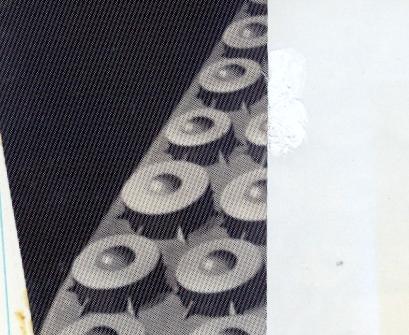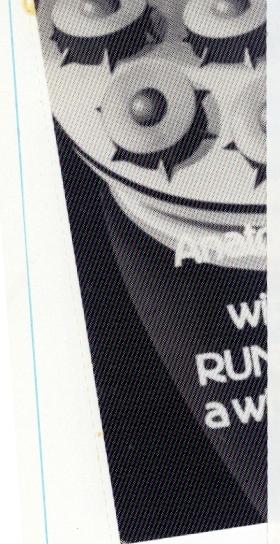| Index | Next |
![]()
Computerized
Footwear
How one man's mind is thrusting
athletic footwear design into areas which border
on science fiction, but which are based on science fact.
by Steve Lloyd
Dr. Gideon Arief, director of Computerized Biomcchanic a Analysis, Inc. and a consultant to the U.S Olympic Committee, has been called the "Leonardo l)a Vinci of sports " But while Da Vinci's studies of the human body were never fully appreciated by his contemporaries, Dr. Ariel is finding an increasingly receptive audience for his computerised analysis of human motion.
A pioneer at tying the science of motion into physical skills necessary to perform athletic feats, Dr. Ariel's studies are helping athletes perform better by revealing to them heretofore undeterminable deterems to optimum performance.
But Dr. Ariel's work isn't limited to helping athletes discover motion efficiency. His computer has been and can be applied to the improvement through redesign of athletic equipment, including, but not limited to shoes, racquets, clubs, bats and halls, and perhaps most importantly. injury preventive and rehabilitative articles and research in sports medicine
The 39-year-old native of Israel combines the esotenca (if computer science with the old athletic standby: high speed, slow-motion and stop-action photography applied with the century old principles of Newtonian physics
-B y analyzing high speed films (as fast as 10,000 frames per second) frame-by-frame. using equipment interfaced with our computer, we calculate velocity, acceleration, direction and angle of forces on all body joints. From that a whole new dimension of data becomes available to us," Ariel says.
Ariel combined science with sport following his own late-blooming career as a discus thrower tin the Israeli teams in the 1960 and 1964 Olympics. During his gruelling eight-hour training sessions he heard one coaching theory after another During his undergraduate years at the University of Wyoming and at Israel's Wingate Institute as a physical education major, his skepticism of countless - and contradictory - coaching theories grew. When he enrolled for master's courses at the newly-established School of Exercise Science at the I'nivrrsity of Massachusetts, Ariel not only put his own thoughts to work there as the track coach, but also plunged himself into the study of calculus. cybernetics, physics. kinetics, medicine and computer technology.
It was at the suggestion of the head of computer sciences at U-Mass that Ariel first toyed with the idea of combining computer analysis with athletics. When he discovered the method of translcrring data into computer hanks via electronic pen ("source plates"), Ariel installed a keyboard terminal in his home and refined his aims. By 1971, he founded Computerized Biomechanical Analysis, Inc. and secured his first contracts for testing athletic
equipment. It wasn't long afterward that athletes themselves came to Ancl for advice.
Ariel is by no means limited to giving advice on improving technique. Through hiomechanics he has prescribed means of rehabilitation for injured athletes in many sports. lie continues his association with the University of Massachusetts by further opening his computer banks to the study of animal behavior. lie even talks of applying hiomechanics to treatment for diabetics and weight watchers, or studies of concert musicians.
While Dr. Ariel uniquely brought together two sciences - biomechanics and computer sciences - it is important to state that his ability to do this was made possible by the collective efforts of many scholars and the technological advances of the past decade in the computer science.
Aricfs work in adapting the immense capabilities of the computer to bring buanechanical analysis into practical service has attracted increased attention in the sports and medical worlds.
Testimony to the tremendous potential of Aricl's work has been lauded by athletes including Mac Wilkins. Terry Albritton and Bill Schmidt; professional teams such as the Dallas Cowboys and the Seattle Super Sonic-, the U.S. Olympic Committee. and the head of its medical staff.
Ariel's studies of the athlete in action have revealed that shoe designers unfortunately have overlooked the fact that shoe efficiency, safety and performance are inextricably tied to the hiomechanics of the activity for which they are used. Toro often, he has concluded, cosmetic features received consideration beyond that given the functional Ieaturcs of shoes.
"In essence," says Ariel, ''all footwear, athletic specifically, cannot he evaluated separately from the athlete in the shoe ' Yet, this apparently is what has happened not only in shoe design. but in nun-partisan evaluation and ranking of shoes by a major running publication."
Because Pony wanted a shoe for the runner, male and female, competitive racer or a recreational jogger. he was chosen to design the first anatomically. hiomcchanically developed and scientifically tested running shoe.
This shoe, as a result, is a radical departure from the norm in athletic shoe production.
"Usually bottom line dollars define product appearance and quality Ilowever, Pony, a young and energetic sports shoe company, made a corporate commitment to quality of function rather than appearance through the unique science of Dr. Aricl," says Thorn Gravelle, executive-vice president of Pony.
With this shoe, Pony, through Dr Ariel's Massachusetts-based laboratory, has hrgoo a dircciion.11 change of sports shoe production forcheo
[low they did it is it fascinating st,,n
CANADIAN FOOTWEAR JOURNAL August 1 f



![]()
| Index | Next |